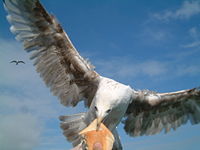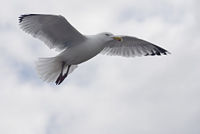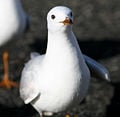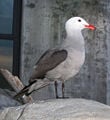Gull
- "Seagull" redirects here.
| Gulls | ||||||||||||
|---|---|---|---|---|---|---|---|---|---|---|---|---|
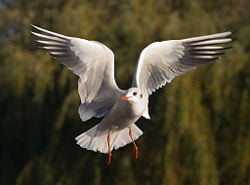 Black-headed Gull
| ||||||||||||
| Scientific classification | ||||||||||||
| ||||||||||||
|
Larus |
Gulls are birds in the family Laridae. They are most closely related to the terns (family Sternidae) and only distantly related to auks, and skimmers, and more distantly to the waders. Most gulls belong to the large genus Larus.
They are typically medium to large birds, usually grey or white, often with black markings on the head or wings. They have stout, longish bills, and webbed feet. Gull species range in size from the Little Gull, at 120 g (4.2 oz) and 29 cm (11.5 inches), to the Great Black-backed Gull, at 1.75 kg (3.8 lbs) and 76 cm (30 inches).
Most gulls, particularly Larus species, are ground nesting carnivores, which will take live food or scavenge opportunistically. The live food often includes crabs and small fish. Apart from the kittiwakes, gulls are typically coastal or inland species, rarely venturing far out to sea. The large species take up to four years to attain full adult plumage, but two years is typical for small gulls.
Gulls — the larger species in particular — are resourceful and highly-intelligent birds, demonstrating complex methods of communication and a highly-developed social structure - for example many gull colonies display mobbing behaviour, attacking and harassing would-be predators and other intruders.[1] In addition, certain species (e.g. the Herring Gull) have exhibited tool use behaviour. Many species of gull have learned to co-exist successfully with man and have thrived in human habitats. Others rely on kleptoparasitism to get their food.
Two terms are in common usage among gull enthusiasts for subgroupings of the gulls:
- Large white-headed gulls for the 16 Herring Gull-like species from Great Black-backed Gull to Lesser Black-backed Gull in the taxonomic list below
- White-winged gulls for the two Arctic-breeding species Iceland Gull and Glaucous Gull
Hybridisation between species of gull occurs quite frequently, although to varying degrees depending on the species involved (see Hybridisation in gulls). The taxonomy of the large white-headed gulls is particularly complicated.
In common usage, members of various gull species are often referred to as sea gulls or seagulls. This name is used by the layman to refer to a common local species or all gulls in general, and has no fixed taxonomic meaning.
The American Ornithologists' Union combines Sternidae, Stercorariidae, and Rhynchopidae as subfamilies in the family Laridae, but recent research (Paton et al., 2003; Thomas et al., 2004; Paton & Baker, 2006) indicates that this is incorrect.
List of gulls in taxonomic order
Genus Larus
- Dolphin Gull, Larus scoresbii
- Pacific Gull, Larus pacificus
- Belcher's Gull, Larus belcheri
- Olrog's Gull, Larus atlanticus
- Black-tailed Gull, Larus crassirostris
- Grey Gull, Larus modestus
- Heermann's Gull, Larus heermanni
- White-eyed Gull, Larus leucophthalmus
- Sooty Gull, Larus hemprichii
- Common Gull or Mew Gull, Larus canus
- Audouin's Gull, Larus audouinii
- Ring-billed Gull, Larus delawarensis
- California Gull, Larus californicus
- Great Black-backed Gull, Larus marinus
- Kelp Gull, Larus dominicanus
- Glaucous-winged Gull, Larus glaucescens
- Western Gull, Larus occidentalis
- Yellow-footed Gull, Larus livens
- Glaucous Gull, Larus hyperboreus
- Iceland Gull, Larus glaucoides
- Thayer's Gull, Larus thayeri
- Herring Gull, Larus argentatus
- Heuglin's Gull, Larus heuglini
- American Herring Gull, Larus smithsonianus
- Yellow-legged Gull, Larus michahellis
- Caspian Gull, Larus cachinnans
- East Siberian Herring Gull, Larus vegae
- Armenian Gull, Larus armenicus
- Slaty-backed Gull, Larus schistisagus
- Lesser Black-backed Gull, Larus fuscus
- Great Black-headed Gull, Larus ichthyaetus
- Brown-headed Gull, Larus brunnicephalus
- Grey-headed Gull, Larus cirrocephalus
- Hartlaub's Gull, Larus hartlaubii
- Silver Gull, Larus novaehollandiae
- Red-billed Gull, Larus scopulinus
- Black-billed Gull, Larus bulleri
- Brown-hooded Gull, Larus maculipennis
- Black-headed Gull, Larus ridibundus
- Slender-billed Gull, Larus genei
- Bonaparte's Gull, Larus philadelphia
- Saunders' Gull, Larus saundersi
- Andean Gull, Larus serranus
- Mediterranean Gull, Larus melanocephalus
- Relict Gull, Larus relictus
- Lava Gull, Larus fuliginosus
- Laughing Gull, Larus atricilla
- Franklin's Gull, Larus pipixcan
- Little Gull, Larus minutus
Genus Rissa
- Black-legged Kittiwake, Rissa tridactyla
- Red-legged Kittiwake, Rissa brevirostris
Genus Pagophila
- Ivory Gull, Pagophila eburnea
Genus Rhodostethia
- Ross's Gull, Rhodostethia rosea
Genus Xema
- Sabine's Gull, Xema sabini
Genus Creagrus
- Swallow-tailed Gull, Creagrus furcatus
The Laridae are known from fossil evidence since the Early Oligocene, some 30-33 mya. A fossil gull from the Late Miocene of Cherry County, USA is placed in the prehistoric genus Gaviota; apart from this and the undescribed Early Oligocene fossil, all prehistoric species are at least tentatively assigned to the modern genus Larus, q.v.
Gallery
Western Gull in Monterey, United States
Gull chick at Trondheim, Norway
A Black-headed Gull in Devon, England
The Swallow-tailed Gull, endemic inhabitant of the Galápagos Islands.
Silver Gull at Sale, Australia
Ring-billed Gulls at Chesapeake Bay
Ring-billed Gull at Toronto, Ontario, Canada
- Peserina2.jpg
Dolphin Gull at Ushuaia, Tierra del Fuego
- Larus smithsonianus-USFWS.jpg
American Herring Gull on its nest
Herring Gulls mating
ReferencesISBN links support NWE through referral fees
- ↑ Alcock, J. (1998) Animal Behavior: An Evolutionary Approach (6th edition). Sinauer Associates, Inc. Sunderland, Massachusetts. ISBN 0-87893-009-4
- Olsen, Klaus Malling & Larsson, Hans (1995): Terns of Europe and North America. Christopher Helm, London. ISBN 0-7136-4056-1
- Paton, Tara A. & Baker, Allan J. (2006): Sequences from 14 mitochondrial genes provide a well-supported phylogeny of the Charadriiform birds congruent with the nuclear RAG-1 tree. Molecular Phylogenetics and Evolution 39(3): 657–667. DOI:10.1016/j.ympev.2006.01.011 (HTML abstract)
- Paton, T. A.; Baker, A. J.; Groth, J. G. & Barrowclough, G. F. (2003): RAG-1 sequences resolve phylogenetic relationships within charadriiform birds. Molecular Phylogenetics and Evolution 29: 268-278. Digital object identifier (DOI): 10.1016/S1055-7903(03)00098-8 (HTML abstract)
- Thomas, Gavin H.; Wills, Matthew A. & Székely, Tamás (2004): A supertree approach to shorebird phylogeny. BMC Evol. Biol. 4: 28. Digital object identifier (DOI): 10.1186/1471-2148-4-28 PDF fulltext Supplementary Material
External links
- Rudy's Gull-index: Pictures of several less well-known plumages of large gulls plus many links.
- The Norwegian Gull Page: Huge picture archive including all NW European species, as well as features from the Nearctic and SE Europe.
- Bird pictures - Gulls: Pictures and descriptions of large gulls from The Netherlands, France, Spain and Poland.
- Bird Hybrids Database: Search for specific laridae hybrids by entering gull species name in query box. Click on hybrid for references.
- Gull videos on the Internet Bird Collection
Credits
New World Encyclopedia writers and editors rewrote and completed the Wikipedia article in accordance with New World Encyclopedia standards. This article abides by terms of the Creative Commons CC-by-sa 3.0 License (CC-by-sa), which may be used and disseminated with proper attribution. Credit is due under the terms of this license that can reference both the New World Encyclopedia contributors and the selfless volunteer contributors of the Wikimedia Foundation. To cite this article click here for a list of acceptable citing formats.The history of earlier contributions by wikipedians is accessible to researchers here:
The history of this article since it was imported to New World Encyclopedia:
Note: Some restrictions may apply to use of individual images which are separately licensed.
